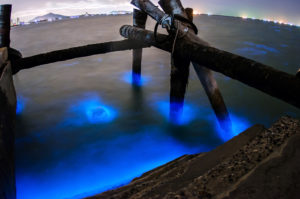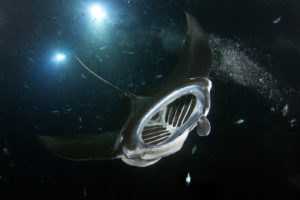Just as on land, where the nocturnal world is quite different from the daytime one, so too does a new environment appear underwater after dark. Even your most regular dive spot becomes mysterious at night. But what makes a night dive so different from a daytime dive? Here are five great night dive experiences you can only have after the sun goes down.

Bioluminescence
Bioluminescence is one of the ocean’s most magical night dive experiences. The phenomenon — the production of light by a living organism — looks like suspended fairy lights underwater. Though it’s possible to see bioluminescence on land, it’s most common underwater thanks to the many vertebrates and invertebrates in the ocean. Many deep-sea creatures use it as a defense or to lure prey, but the simplest way to experience bioluminescence as a diver is via the tiny plankton in the ocean that glow when set in motion. Simply cover you light and wave your hand through the water to create a magic light show.
Sleeping sea creatures
When nocturnal animals awaken on the reef, daylight creatures go to sleep. Lucky night divers might spy a sleeping turtle — do not disturb — and lots of reef fish in a deeply relaxed state. Scientists are still researching the nature of fish sleep, as many animals only rest and maintain awareness of predators. On a reef you’ll see many tucked away in the nooks and crannies of the coral providing them shelter and protection for the night. Parrotfish actually secrete a protective mucus bubble around themselves or across the entrance to their hiding spots in the reef to ward of predators or parasites while they rest. If you’re diving early in the morning, watch for discarded mucus bags, floating in the water like snot.
Special note: As every good diver knows, you should never touch marine life. This is even more important at night, so never touch sleeping animals or shine your torch on one for too long.
Coral
Coral reefs are spectacular during the day, but they’ll wow you at night as well. As light is filtered out, colors become muted the deeper we go. But at night, your light source is much closer — the torch in your hand. In that concentrated light, colors will appear much more vivid than during the day. In addition, colorful coral polyps open up at night to feed on nutrients in the ocean, so pause on your next night dive and give the coral a good look.

Manta rays
There are several spots around the world where you can do night dives with mantas. Lucky divers will see large feeding aggregations of dozens of mantas, unfolding like a nighttime ballet. These majestic animals swoop and fly, feeding on the plankton and small creatures that are drawn to the light of divers’ torches or the dive-boat lights. La Paz, Mexico; Raja Ampat, Indonesia; and Kona, Hawaii are some of the most famous spots for these encounters.
Enhanced perception
At night everything is different, even our perception. Not only does the darkness alter your sense of what’s around you, but it also enhances things like your perception of sound. Popular sites are usually far quieter at night, with fewer boat engines and less diver activity. Through this quiet, you start to notice natural sounds become amplified, such as the crackling and popping sounds that are far more pronounced than during the day. Various marine creatures produce the sound when they eat algae or coral polyps off the reef, combined with the sound of small shrimp snapping their claws. Keep your ears open during your night dives and you’ll hear a whole new world.
The post Five Great Night Dive Experiences appeared first on Scuba Diver Life.
from Scuba Diver Life https://ift.tt/2pSUyCN
No comments:
Post a Comment